Archived Storm Damage Blog Posts
Children and Youth Preparedness
2/9/2022 (Permalink)
Children and Youth Preparedness for disasters and emergencies of all kinds.
Preparing for a disaster as an adult can be overwhelming and taxing, especially if you have children to factor into all of your decisions.
If you plan ahead, you can involve your children in all of the steps that need to be taken. The more prepared your child is, the less anxiety they will feel if an emergency or disaster occurs.
Let's start with the basics
- Teach your child how to dial 911 BEFORE an emergency and show your child the steps for calling 911 on your mobile phone.
- Make sure your child can say his/her first and last name clearly and provide his/her address or location.
- Teach your child to identify a location by buildings, signs or other landmarks. Some 911 centers cannot automatically locate a caller.
- Most of us now have cell phones with us wherever we go, which is great in an emergency situation ,but ,most of us have lock screens on our phones for security, as we should. It's important to teach your children how to unlock your phone in the case of an emergency.
- Go over your mobile phone's keypad several times to help your child become familiar with making a call.
- Have your child practice making a phone call from your mobile phone by calling a family member or friend. Remember not to actually call 911 with your child, unless it's an emergency.
Having people set up as your "emergency contact" is very important. Who’s your emergency contact? Make sure the kids know who it is and how to contact them. Pick the same person for each family member to contact. Pick someone out of town as they may be easier to reach in a disaster.
Make an emergency plan with your family and make sure that your emergency contact and school know the plan in case your child is in school when a disaster occurs.
Things to consider when making a plan
- Your family may not be together if a disaster strikes, so it is important to know which types of disasters could affect your area.
- Know how you’ll contact one another and reconnect if separated.
- Establish a family meeting place that’s familiar and easy to find.
Practice, practice, practice!
Have an emergency kit ready for your child. Include medications that your child takes as well as some comfort items such as stuffed animals, board games and books.
Get kids involved in building their own emergency kit! Make it a family activity or part of a game and explain how the kit and the items in it will help them.
For a more detailed list of items that should go in your kit, follow this helpful link: Build A Kit
Let's stay prepared!
#YouthPrep #ReadyKids
Winter Storm Preparedness 2.0
1/7/2022 (Permalink)
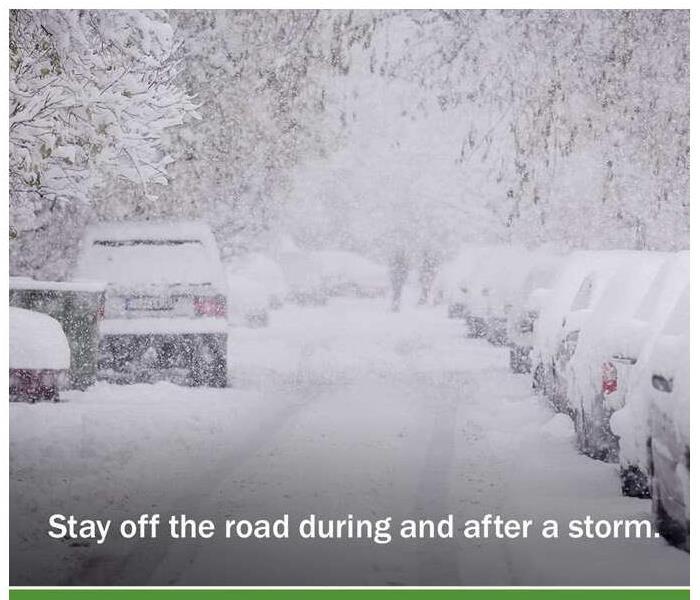 #wintersafety #winterstorm
#wintersafety #winterstorm
Winter has most definitely arrived in the Upper Valley! The snow is falling and the temps have dropped.
This got me thinking about preparedness in 2022!
Things have changed in recent years and we are all living in a different reality, let's take a look at how this will affect or change the things we need to take care of ourselves and our loved ones during the Winter months..
What you should know about Winter Weather.
- Know what to do before, during, and after a winter storm.
- Listen to local officials.
- Have emergency supplies in place at home, at work, and in the car.
- Stay off the road during and after a winter storm. Allow the plow trucks to do their work.
- Have a carbon monoxide alarm in place, especially if using alternative heating devices.
- Use safe heating devices.
Winter storms create a higher risk of car accidents, hypothermia, frostbite, carbon monoxide poisoning, and heart attacks from overexertion. Winter storms including blizzards can bring extreme cold, freezing rain, snow, ice and high winds.
A winter storm can:
- Last a few hours or several days.
- Cut off heat, power and communication services.
- Put older adults, children, sick individuals and pets at greater risk.
Preparing your home for Winters arrival is important.
- Prepare your home to keep out the cold with insulation, caulking and weather stripping.
- Learn how to keep pipes from freezing in your home.
- Install and test smoke alarms and carbon monoxide detectors with battery backups.
- Gather supplies in case you need to stay home for several days without power.
- Keep in mind each person’s specific needs, including medication and don't forget masks..
- Remember the needs of your pets.
- Have extra batteries for radios and flashlights.
If you are unable to afford your heating costs, weatherization or energy-related home repairs, contact the LIHEAP for help.
Avoid carbon monoxide poisoning.
Only use generators and grills outdoors and away from windows. Never heat your home with a gas stovetop or oven.
In case of an emergency
Be prepared for winter weather at home, at work and in your car. Create an emergency supply kit for your car. Include jumper cables, sand, a flashlight, warm clothes, blankets, bottled water and non-perishable snacks. Keep a full tank of gas.
**If you are able to, set aside items like soap, hand sanitizer that contains at least 60 percent alcohol, disinfecting wipes, and general household cleaning supplies that you can use to disinfect surfaces you touch regularly.
Stay off roads if at all possible. If trapped in your car, then stay inside.
Limit your time outside. If you need to go outside, then wear layers of warm clothing. Watch for signs of frostbite and hypothermia.
Reduce the risk of a heart attack by avoiding overexertion when shoveling snow and walking in the snow.
#WinterSafety #WinterStorm
Why SERVPRO for your storm relief?
11/1/2021 (Permalink)
Why SERVPRO for your storm relief?
Because we are Faster To Any Size Disaster and we are a 24 Hour Emergency Service!
Disasters don't happen when it's convenient, but you can rely on us to get there because of our service response guidelines!
Whether it's fire, water or a storm; disasters come in all shapes and sizes!
To learn more about our guidelines and why we're faster to any size disaster, check out our guidelines below.
SERVICE RESPONSE GUIDELINES
Damage of any kind to your business; especially fire, storm or water damage, can be stressful for owners, property managers, employees and tenants.
Property damage, equipment damage, document loss and temporary business closure are just some of the concerns you may experience.
Timely response and thorough mitigation can alleviate these concerns.
The first 24 hours can make the difference between restoring versus replacing your business property and belongings.
SERVPRO of Lebanon/Hanover/Littleton's 1-4-8 Service Response Guidelines can prevent Fire/Water and storm damage from creating long term problems.
- Within 1 hour from notice of loss, a SERVPRO of Lebanon/Hanover/Littleton Professional contacts you to arrange for services.
- Within 4 hours of loss notification, a SERVPRO of Lebanon/Hanover/Littleton professional is on-site to start mitigation services.
- Within 8 business hours of on-site arrival, a verbal briefing of the scope is communicated to the appropriate person.
**Exceptions may apply under certain conditions, such as a local catastrophic event or storm situation which could make getting around dangerous due to downed power lines or flooding.
Have Questions about Fire, Smoke, Storm or Water Damage?
Call Us Today - (603) 298-6942
Storms come in all shapes and sizes and types?
9/27/2021 (Permalink)
Not all storms come in the form of a weather related disaster; some storms can't be seen. But; they can still be prepared for.
The CDC strives to continuously gather data and information in an attempt to give us the most current information available.
Pandemics are something most of us have not had to deal with in our lifetime but are something that we have seen before.
A pandemic is a disease outbreak that spans several countries and affects a large number of people. Pandemics are most often caused by viruses, like Coronavirus Disease 2019 (COVID-19), which can easily spread from person to person.
A new virus, like Covid-19, can emerge from anywhere and quickly spread around the world. It is hard to predict when or where the next new pandemic will emerge.
According to the CDC, if a pandemic is declared, there are some basic steps to follow.
- Wash your hands often with soap and water for at least 20 seconds and try not to touch your eyes, nose or mouth.
- Keep a distance of at least six feet between yourself and people who are not part of your household.
- Cover your mouth and nose with a mask when in public.
- Clean and disinfect high-touch objects and surfaces.
- Stay at home as much as possible to prevent the spread of disease.
- Follow the guidance of the CDC
How to Prepare Yourself for a Pandemic.
- Learn how diseases spread to help protect yourself and others. Viruses can be spread from person to person, from a non-living object to a person and by people who are infected but don’t have any symptoms.
- Prepare for the possibility of schools, workplaces and community centers being closed. Investigate and prepare for virtual coordination for school, work (telework) and social activities.
- Gather supplies in case you need to stay home for several days or weeks. Supplies may include cleaning supplies, non-perishable foods, prescriptions and bottled water. Buy supplies slowly to ensure that everyone has the opportunity to buy what they need.
- Create an emergency plan so that you and your family know what to do and what you will need in case an outbreak happens. Consider how a pandemic may affect your plans for other emergencies.
- Review your health insurance policies to understand what they cover, including telemedicine options.
- Create password-protected digital copies of important documents and store in a safe place. Watch out for scams and fraud.
Preparation is key to any disaster or storm and we've covered what you can do to be as prepared as you can be. The CDC offers much information on how you can keep yourself safe during and after a pandemic.
Staying safe and prepared is the SERVPRO way!
Low-Cost, No-Cost Preparedness
9/15/2021 (Permalink)
 Prepare To Protect
Prepare To Protect
In keeping with the National Preparedness Month, I thought I'd put together as much information as I could find on preparing with a budget and ways to prepare ahead of time.
Let's face it, there are things that will ultimately have to be purchased for emergency kits, so planning ahead is something that we can all do and preparing a list of things that you need, and purchasing items weekly can really help with the budget!
Ready.gov has a wealth of information for you regarding ALL of your disaster preparation needs.
You can also visit SERVPRO of Lebanon/Hanover/Littleton's website blog section for disaster related blogs and tons of preparedness information Here.
A great first step to preparing yourself for disaster, is to find out exactly what you need to prepare.
You can download or order your FREE preparedness products to help your family plan and prepare for the next emergency here: Free Publications
A very important part of preparing your family for a disaster is to know what to do the moment a disaster occurs. Have a plan in place and remember, Drills aren’t just for your toolbox. Practice emergency drills with your family regularly.
Emergencies can happen anytime, and less than half of American families have a communication plan. Plan ahead with your family!
For information on making a plan with your kids, follow this link: Make a Plan
Make preparing fun for kids! Go on a scavenger hunt around your house for items you already have to add to your disaster supply kit.
Follow this list: Build a Kit and see how many items you can check off!
Know what disasters and hazards could affect YOUR area, how to get emergency alerts, and where you would go if you and your family need to evacuate.
Visit Be Informed to find out how to get information specific to you and your area.
A little preparation can make the difference in a life threatening situation!
#PrepareToProtect #BeReady
What you should know about Flood Safety
9/7/2021 (Permalink)
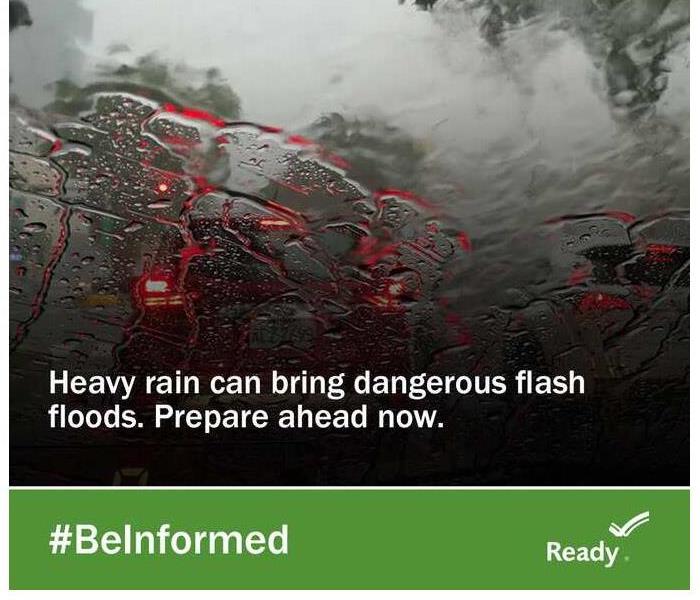 Be Prepared!
Be Prepared!
Flood Safety is something that we must consider more and more in the Northeast. Flash flooding is a term we are getting all to used to hearing.
September brings with it National Preparedness Month. We're used to preparing for the Winter months up here, not so much floods. I think it's time we start thinking about floods, Don't you? Let's DIVE in shall we!
Below is a list of things to consider ahead of the next rainy season.
- Make a family emergency communication plan and include pets.
For information on how to get started; follow this link: Make a Plan - Have emergency supplies in place at home, at work, and in the car.
For information on what your emergency kit should hold; follow this helpful link: Build a Kit - Check on your neighbors to make sure they’re okay. Especially your elderly neighbors who may not be able to gather the supplies needed to ride out a storm.
- Know what to do before, during, and after a flood. To learn more about the three stages of flood preparation, follow this informative link: Floods
- Flood insurance takes 30 days to take effect, so purchase now to protect your family!
- Homes are not the only thing at risk! If you are a business owner, you have many other things that need to be considered about how you can prepare for a disaster at your business. For a comprehensive list of needs and considerations for your business, follow this informative link: Business
- Listen to local officials by radio, TV or social media. In case of power outages, have a battery powered radio on hand so that you won't miss important information.
- Evacuate when advised by authorities or if you are in a flood or flash flood prone area. Know your evacuation route!
- If you are on high ground above flooded areas, being prepared to stay where you are may be the best protection.
- Never drive or walk through flooded streets; Turn Around, Don’t Drown! Do not go through flood waters.
For more information about ANY type of disaster preparedness, follow this helpful link: https://www.ready.gov/
#BeInformed
Commercial Storm flooding
10/14/2020 (Permalink)
A storm has caused flooding in my business!!
What are some of the things that SERVPRO can do when my business suffers storm damage and flooding?
Flooded business dry-out information:
- Pump Deep Water
- Carpet Water removal
- Moisture Test walls
- Set up Drying Equipment
- Apply Antimicrobials
- Test Drying Complete
Acting quickly is key!
Leaving water or moisture can cause damage to the rest of the structure as well as where the damage occurred.
Imagine the condensation that could happen when it's 90* outside. The concrete or cement blocks used to construct basements and buildings are susceptible to mold growth as well as odor.
Imagine all of the exposed framing. Framing lumber does and will absorb moisture and thus, grow mold. The metal framing ties may not be porous enough for mold growth; but they will corrode.
How about the plumbing and wiring?
Again, any metal parts can and most likely will corrode with excess moisture in the air.
The insulation! Perfect for mold growth!
SERVPRO of Lebanon / Hanover / Littleton has the training, experience, and equipment to handle large commercial flooding or water damage emergencies.
Whether your water emergency occurs in a small office building or big box store, we will respond quickly to mitigate the damage and manage the restoration project through to its completion.
If you have a flooding situation, SERVPRO of Lebanon/Hanover/Littleton is prepared and ready! Call 603-298-6942 24 hours a day, 365 days a year!
For more helpful information on our Water Damage Repair and Restoration Services, follow this helpful link: Water Damage.
"Like it never even happened."
Storm Preparedness for your vehicle
9/23/2020 (Permalink)
Nor'easter
A Nor'easter is a type of storm that forms along the East Coast of North America. Nor'easters are named after the direction from which the strongest winds typically blow over the northeast states, including New England and the Mid-Atlantic states. The storms can bring wind, snow, rain and flooding to these regions.
Traveling in the winter months can be beautiful and fun! It's important to always be prepared for the unexpected. winter storms can pop up at anytime and you can find yourself stranded in your car for some time. Being prepared can be a life saver!
According to Ready.gov, having these essentials in your car during the winter are recommended.
Emergency Kit for the Car
- Jumper cables
- Flares or reflective triangle
- Ice scraper
- Car cell phone charger
- Blanket
- Map
- Cat litter or sand (for better tire traction)
Prepare Your Car for Emergencies
Having your mechanic check your vehicle before an emergency can occur is a good thing! Have your mechanic check all of the below:
- Antifreeze levels
- Battery and ignition system
- Brakes
- Exhaust system
- Fuel and air filters
- Heater and defroster
- Lights and flashing hazard lights
- Oil
- Thermostat
- Windshield wiper equipment and washer fluid level
Car Safety Tips
- Keep your gas tank full in case of evacuation or power outages. A full tank will also keep the fuel line from freezing.
- Install good winter tires and make sure they have enough tread, or any chains or studs required in your local area.
- Do not drive through flooded areas. Six inches of water can cause a vehicle to lose control or possibly stall. A foot of water will float many cars.
- If a power line falls on your car you are at risk of electrical shock. Stay inside until a trained person removes the wire.
- If it becomes hard to control the car, pull over, stop the car and set the parking brake.
SERVPRO of Lebanon/Hanover/Littleton wishes you all a happy and SAFE winter season!
Whatever the emergency situation may be, stay informed by visiting Ready.gov
Storm preparedness part 2, After the storm
9/14/2020 (Permalink)
 Is your kit ready?
Is your kit ready?
Only 51.5% of people have an emergency ready kit, Do you have a kit?
After a storm or emergency occurs, you may find that you are without power for days and may need to survive on your own until storm cleanup has been completed and power has been restored.
Having a checklist of needed items to put in your preparedness kit is very helpful.
According to https://www.ready.gov/kit this is a basic disaster kit and the supplies that should be in it.
To assemble your kit store items in airtight plastic bags and put your entire disaster supplies kit in one or two easy-to-carry containers such as plastic bins or a duffel bag.
- Water (one gallon per person per day for at least three days, for drinking and sanitation)
- Food (at least a three-day supply of non-perishable food)
- Battery-powered or hand crank radio and a NOAA Weather Radio with tone alert
- Flashlight
- First aid kit
- Extra batteries
- Whistle (to signal for help)
- Dust mask (to help filter contaminated air)
- Plastic sheeting and duct tape (to shelter in place)
- Moist towelettes, garbage bags and plastic ties (for personal sanitation)
- Wrench or pliers (to turn off utilities)
- Manual can opener (for food)
- Local maps
- Cell phone with chargers and a backup battery
Additional personal emergency kit supplies
- Cloth face coverings (for everyone ages 2 and above), soap, hand sanitizer, disinfecting wipes to disinfect surfaces
- Prescription medications
- Non-prescription medications such as pain relievers, anti-diarrhea medication, antacids or laxatives
- Prescription eyeglasses and contact lens solution
- Infant formula, bottles, diapers, wipes and diaper rash cream
- Pet food and extra water for your pet
- Cash or traveler's checks
- Important family documents such as copies of insurance policies, identification and bank account records saved electronically or in a waterproof, portable container
- Sleeping bag or warm blanket for each person
- Complete change of clothing appropriate for your climate and sturdy shoes
- Matches in a waterproof container
- Feminine supplies and personal hygiene items
- Mess kits, paper cups, plates, paper towels and plastic utensils
- Books, games, puzzles or other activities for children
Maintain your kit
Keep canned food in a cool, dry place.
Store boxed food in tightly closed plastic or metal containers.
Replace expired items as needed.
Re-think your needs every year and update your kit as your family’s needs change.
Kit storage locations
Home: Keep this kit in a designated place and have it ready in case you have to leave your home quickly. Make sure all family members know where the kit is kept.
Work: Be prepared to shelter at work for at least 24 hours. Your work kit should include food, water and other necessities like medicines, as well as comfortable walking shoes, stored in a “grab and go” case.
Car: In case you are stranded, keep a kit of emergency supplies in your car.
SERVPRO is prepared 24 hours a day, Seven days a week to help you with your emergency situation!
Preparing for Winter in the Summer?
9/8/2020 (Permalink)
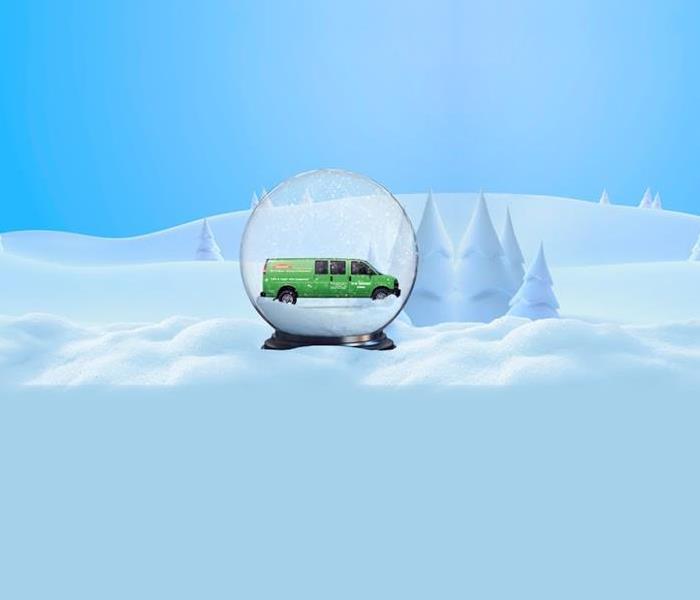 Heading into Winter prepared!
Heading into Winter prepared!
Winter will sneak up on us quicker than you think; especially in the Northeast!
So, what can we do now to prepare for what's coming? Here are some tips on getting prepared for Winter; in the Summer..
Gutters
If you have gutters on your home, like many of the older homes do in the Northeast; Now would be a good time to give them an overhaul.
Check for any repairs that may need to be made and clean them out. Without clean gutters and proper flow control, you might be dealing with icy front steps this winter! Be sure to clean your gutters so melting snow and freezing rain can flow away from your walking areas and foundation.
Equipment
If you own a snow blower, now would be a good time to check the tires and fluids and give it a good cleanup. You don’t want to have to deal with that at 5am when you need to get to work and there is a foot of snow on the ground.
Outside Water lines
Draining the Pipes is a good idea if you have an "outside water line." It is recommended that you turn off outside water sources. Turn off the water lines and then open the spigots outside to drain the line. This is a simple task that could save you lots of money and a huge headache with burst pipes.
Furnace
Have your furnace serviced if necessary, furnace filters need to be changed monthly to ensure clean air in the winter time. It also improves the effectiveness of your furnace and can reduce your energy bills.
Fire and Smoke detectors
With fall and winter come holiday dinners, nights around the fireplace, and lighting our Warm Apple Pie spice candles. Now is the time to make sure all your detectors have fresh batteries and your alarms are set and ready!
Chimney
Whether you have a fireplace or a wood stove, it is always a good idea to get your chimney cleaned and looked over every year. Replace broken bricks as you find them. Doing it now can save you from having to get on your roof in the Winter!
Prepare your yard
We often think of just our homes, and how we can prepare them for Winter. But, just one simple step can help you have a healthier lawn in the Spring.
Once you've done your last mowing for the season, sprinkle on lawn fertilizer. This helps to ensure stronger roots and a thicker lawn, as well as giving your soil nutrients to help during the cold months.
These are just some of the things that you can do in the Summer to get you ready for the Winter!
Here to Help!
9/4/2020 (Permalink)
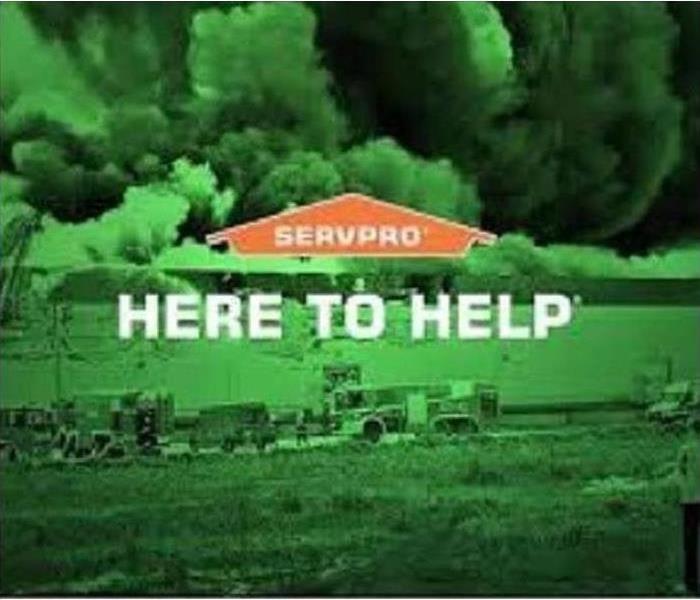 Here to help in your time of need
Here to help in your time of need
Research shows since 1980, the occurrence of weather related disasters has increased by more than 230 percent.
According to AccuWeather, natural disasters have affected 217 million people every single year since 1990.
The SERVPRO Commercial Large Loss division is composed of our best of the best in restoration.
Our elite large loss specialists are prequalified and strategically positioned throughout the United states to handle any size disaster.
The SERVPRO Disaster Recovery Team can provide help whether you're dealing with a tornado, hurricane, blizzard or flood.
Every large loss is supervised by a commercial operations manager to help ensure seamless communication and timely mitigation.
At SERVPRO of Lebanon/Hanover/Littleton, the difference is our ability to dispatch trained production professionals and cut costs through strategic placement and oversight of temporary labor.
With the ability to mobilize local command centers, along with the resources of more than 1,650 franchises nationwide, no disaster is too big. Available 24 hours a day and 365 days a year, SERVPRO of Lebanon/Hanover/Littleton professionals are prepared for the unpredictable.
Should a storm or major event strike, call 603-298-6942, and we'll make it "Like it never even happened."
Commercial storm loss
6/24/2020 (Permalink)
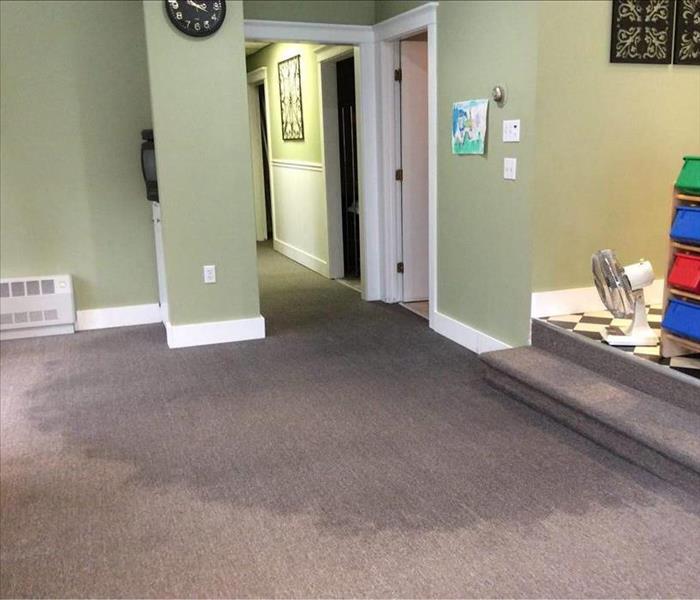 Salon suffers water damage
Salon suffers water damage
Research shows since 1980, the occurrence of weather related disasters has increased by more than 230 percent.
According to AccuWeather, natural disasters have affected 217 million people every single year since 1990.
The SERVPRO Commercial Large Loss division is composed of our best of the best in restoration.
Our elite large loss specialists are prequalified and strategically positioned throughout the United states to handle any size disaster.
The SERVPRO Disaster Recovery Team can provide help whether you're dealing with a tornado,hurricane,blizzard or flood.
Every large loss is supervised by a commercial operations manager to help ensure seamless communication and timely mitigation.
At SERVPRO of Lebanon/Hanover/Littleton, the difference is our ability to dispatch trained production professionals and cut costs through strategic placement and oversight of temporary labor.
With the ability to mobilize local command centers,along with the resources of more than 1,650 franchises nationwide, no disaster is too big. Available 24 hours a day and 365 days a year, SERVPRO of Lebanon/Hanover/Littleton professionals are prepared for the unpredictable.
Should a storm or major event strike, call 603-298-6942.
https://www.SERVPROlebanonhanoverlittleton.com/
"Like it never even happened."
What should I do? My home has been damaged!
1/3/2020 (Permalink)
What steps should I take immediately after storm damage?
Take Safety Precautions for yourself above all..
If needed, arrange for an alternative place for you and your family to live while your property is being restored to safe living condition.
Heavy winds and rain can create physical hazards such as collapsed roofing materials, window damage, collapsed walls or standing water in the basement or home interior.
Shut off the main gas line if you smell gas!
Do not step in standing water without first making sure power is turned off to avoid risk of electrocution.
Beware of broken glass, exposed nails, and other sharp objects on the property.
Contact SERVPRO of Lebanon/Hanover/Littleton to help do basic tasks to help secure your property and make it safe to use.
Photograph and Document the Damage
- If it is safe to move around your property, use your cellphone or a camera to photograph the damage so that you will have a record for your insurance company. This action will ensure that you are fully compensated.
Contact Your Homeowners Insurance Agency immediately.
- Contact your insurance agent to notify them about the damage to your home immediately. The company will send out an adjuster to determine the extent of the damage so that payment for repairs can be made.
Give us a call at 603-298-6942 if you are in need of some assistance following a storm or just have questions, We are here to help!
Skyler Says..Do you need help before the snow arrives?
10/14/2019 (Permalink)
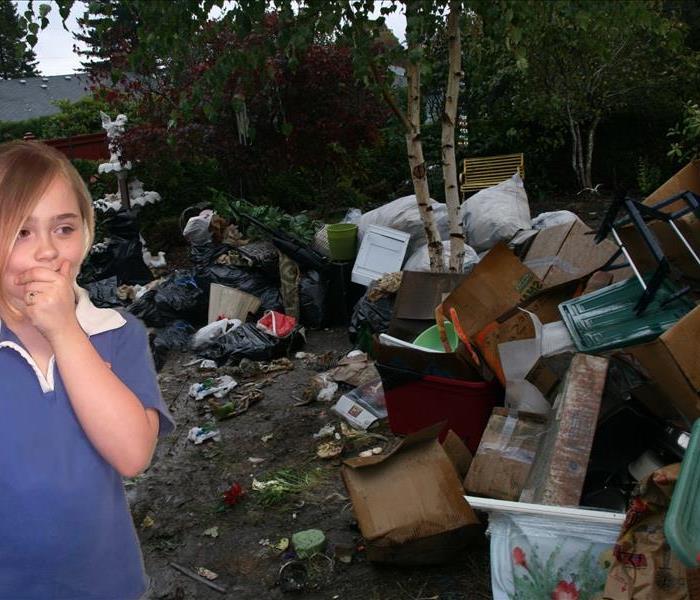 Let's get ready for Winter!
Let's get ready for Winter!
Skyler Says...
Do you need some help with cleanup before the snow falls? But you don't have time to get it all done?
Winter storms can be beautiful and festive; Winter storms can also be dangerous! Winter storms often bring with them high winds that can cause a lot of damage. Making sure that the outside of your home and yard are clear of any debris that could turn into a projectile is imperative!
Don't sweat it, SERVPRO has got you covered! Give us a call today at 603-298-6942 and we'll come out and get you ready for Winter.
Winter is fast approaching and we all love a snow day in the Upper Valley!!
9/23/2019 (Permalink)
Prevent Winter Damage today!
The reality is that major winter storms can wreak havoc in our everyday lives, causing inconvenience, discomfort and expensive damage.
Keep your home protected from these disruptions by following these tips:
- Start by cleaning out the gutters.This allows melting snow a place to go and is helpful in the prevention of ice dams.
- Inspect the roof for damaged shingles and damaged roof flashing. Both of which can let water into your home.
- Check your Chimney for cracks and leaning. Both will need to be repaired before the winter sets in. Make sure that your chimney has a cap that is properly installed.
- Get yourself a roof rake. Removing large amounts of snow from your roof will eliminate the chances of a roof collapse and help keep away the formations of ice dams.
- Check your pipes. If you have pipes that are on exterior walls or unheated areas of your home; get them insulated before the really cold temperatures hit. No one wants to deal with burst pipes!
- know where the main water valve is in your home. This is imperative if you do end up with some burst pipes.
Personal safety is a must!
- Keep walkways clear of snow and ice with deicing products and make sure to have clear paths to your main water valve and circuit breaker in case of emergency.
- Create and maintain a safety kit for each person in the event of an extended power outage.
For information on kits and what you should have in them; click here
Safety is the name of the game!
#HereToHelp #SERVPROofLebanon/Hanover/Littleton
Storm Safety Tips for the Upper Valley
9/13/2019 (Permalink)
Fall tips for the Upper Valley
Fall brings with it cooler temps, pumpkins and beautiful falling leaves. Fall is a beautiful time of year in the Upper Valley and we don't tend to get a lot of storms, but when we do; they often bring high winds and rain with them.
As New Englanders, we need to make sure that we are prepared for the upcoming Winter storms as well as all of our Fall duties.
Here are some tips to help with your Fall and bring you into Winter.
- Always keep a battery-powered radio in your home so that you can tune to radio stations if you lose electricity. Check the batteries frequently.
- Keep a flashlight in an easily accessible spot on every floor of your home. Check the batteries monthly.
- Keep a supply of candles on hand for power failures.
- Keep gutters free of leaves and debris.
- Make sure that your yard is kept free of items such as, tree limbs and yard tools. These can become projectiles in a wind event.
- If you haven't already, have your furnace serviced before the cold weather hits.
- Reconsider Leaf Burning! According to the EPA, burning leaves produces air pollution which can lead to health problems.
- Be sure to use caution if using space heaters,always allow at least three feet of empty area around space heaters.
Above all else, let's have a safe and a happy Fall season! SERVPRO cares!
Winter Storm Preparedness Part1
9/9/2019 (Permalink)
Be prepared before a winter storm hits by planning ahead.
During really cold weather or winter storms, staying safe and warm presents many challenges! Storms bring with them very cold temps, power outages,icy roads and loss of communication. With some planning, you cab be prepared!
Weatherproofing your home will help to keep you warm, Some tips on this are..
- Insulate any water lines that run along exterior walls so your water supply will be less likely to freeze.
- Caulk and weather-strip doors and windows.
- Make sure that your homes walls and attic are properly insulated.
- Install storm or thermal-pane windows or cover windows with plastic from the inside.
- Repair roof leaks and cut away tree branches that could fall on your home or other structure during a storm.
- If possible, having a generator when you live in colder climates is a plus.
- If you are using wood as your source of heat, have your chimney or flue inspected every year. Always make sure to have battery operated smoke and carbon detectors.
Have a list of important phone numbers in case of emergency. This should include your physician, pediatrician, pharmacist, and veterinarian.
Other important numbers to have are:
Poison Control Center: 800-222-1222
Animal Poison Control Helpline: 888-426-4435
Disaster Distress Helpline: 800-985-5990
According to FEMA, over 60% of people do not have an emergency plan in place. Start yours today!
Winter Storm Preparedness Part 2
9/9/2019 (Permalink)
In winter storm preparedness Part 1 we discussed preparing your home..
Let's discuss you car and Emergency kits in Part 2!
You may find yourself having to travel in the winter at some point or maybe there is an emergency and you have to go out in stormy weather. Don't get caught off guard without the basic things that you need.
According to the CDC, here is a list of items that you should have in your car during the winter months.
- Cell phone, portable charger, and extra batteries.
- Items to stay warm such as extra hats, coats, mittens, and blankets.
- Windshield scraper
- Shovel
- Battery-powered radio with extra batteries
- Flashlight with extra batteries
- Water and snack food
- First aid kit with any necessary medications and a pocket knife
- Tow chains or rope
- Tire chains
- Canned compressed air with sealant for emergency tire repair
- Cat litter or sand to help tires get traction, or road salt to melt ice
- Booster cables with fully charged battery or jumper cables
- Hazard or other reflectors
- Bright colored flag or help signs, emergency distress flag, and/or emergency flares
- Waterproof matches and a can to melt snow for water
Make sure that your cars maintenance is up to date before the cold weather hits!
- Replace windshield wiper solution with a wintertime solution.
- Check the antifreeze levels
- Make sure that your tires are winter ready
- Keep gas tank near full to avoid ice in the fuel lines.
Having an emergency kit in your car is a great idea because you never know when you may be stranded in your vehicle or you may have to leave your home quickly and you can't grab your emergency kit from there.
Here are some personal items to have in your emergency kit in addition to what you already have stored in your car:
- Prescription medications.
- Non-prescription medications such as pain relievers, anti-diarrhea medication, antacids or laxatives.
- Glasses and contact lens solution.
- Infant formula, bottles, diapers, wipes, diaper rash cream.
- Pet food and extra water for your pet.
- Cash or traveler's checks.
- Complete change of clothing appropriate for your climate and sturdy shoes.
- Feminine supplies and personal hygiene items.
- Mess kits, paper cups, plates, paper towels and plastic utensils.
- Paper and pencil.
- Books, games, puzzles or other activities for children.
These are recommendations and suggestions, personalize your kits to your special needs.
Being safe and warm during the winter months is vital both in your home and car!
Storm Safety
6/21/2019 (Permalink)
Summer is here, and with it; Summer storms!
Living in the Northeast means Summer storms that can include strong wind gusts,hail,heavy rain and lightning. We usually concern ourselves with our home or our car during storms, and how we can protect them. That is great, and it is
important to take all precautions during a storm. We can't forget ourselves though. We can't always be under the protective roof of our home when a storms rolls in. We need to know how to protect ourselves from the dangers that a
storm can bring.
Lightning can strike from 10 miles away, so if you can hear thunder, you are in danger of being struck by lightning.
If you find yourself caught outside during a storm, look for a substantial building like a school, office building or home to shelter in for the duration of the storm. Once inside, you should stay away from windows and doors and
anything that conducts electricity such as corded phones, wiring and plumbing.
If you are caught outside without a safe shelter anywhere nearby, the following actions can reduce your risk:
- Never shelter under a stand alone tree or utility pole. Lightning tends to strike the taller objects that are in an area.
- Lower your elevation, if you are hiking or on a hillside, immediately make your way down.
- Stay away from sources of water, such as ponds, lakes etc. If you are swimming, get out of the water asap and seek shelter.
It's always best to monitor the weather and postpone or cancel your outdoor activities accordingly. “If you hear thunder, lightning is close enough to pose an immediate threat,” said FEMA Region V Acting Administrator Janet M.
Odeshoo. “Seek shelter as quickly as possible. There is no place outside that is safe when a thunderstorm is in the area.”
For additional information on storm safety visit,https://www.ready.gov/thunderstorms-lightning. You can also find very helpful information on storm preparedness Here.
Spring and Summer storm tips
5/24/2019 (Permalink)
Spring is here and summer is not far behind..Spring and Summer are very unpredictable when it comes to storms. It can bring rain, wind and even hail!
In the Northeast we're used to temps going from 80 one day to 50 the next, This does take it's toll on us! This is why we need to be ever vigilant when it comes to preparing for the storm season inside and out.
Here are some tips for preparing for storm season.
- Assess. Take a walk around your property often to see if there is any damage. Especially after Winter!
- Check your gutters to make sure they are clear of debris and don't neglect to check the roof and chimney for damaged shingles and potential areas where leaking can occur.
- Trim and prune trees of all dead limbs and pick up any that may have fallen over the winter. These can become projectiles in a windy storm.
- Make sure that your sump pump is in working order; Winter thaw and Spring runoff can really wreak havoc in your basement.
- Always make sure that your outside items are secured or better yet; picked up and put away in the case that a storm is coming.
In the Northeast; we have many rural and secluded areas that are beautiful to live in; but with that beauty comes some sacrifices. Many of these homeowners deal with power outages on a pretty regular basis.
So, whether your preparing for a potential storm or are frequently without power; it's always good to plan for the power to be out for an extended period of time.
Think ahead. Make ice, lots of it. This will come in handy with coolers to keep your food fresh and also to keep your refrigerator and freezer cold.
Have a battery powered radio for updates on when the power may be restored to your area.
Make sure that your cell phone is charged.
These are just a few tips to help you have a safe and happy Spring!
Winter came early! Ice dams are coming!
12/8/2018 (Permalink)
Winter sure showed up early here in the northeast! We've had snow since October!
This is a season to be extra vigilant when it comes to ice dams.
Ice dams occur after a heavy snowfall when warm air in the attic causes the roof to warm and the snow to melt. Water running down the roof refreezes when it reaches the colder roof edge, forming a mound of ice. The ice traps meltwater, which can seep back up under shingles and drip through the roof into your house, causing wet and stained ceilings and walls, and peeling paint and rot.
The easiest way to prevent ice dams is by keeping your roof cold.This means never letting your roof temperature exceed 32 degrees. At 32 degrees,snow starts melting.
Most homes heat loss is through the attic and air leaks caused by unblocked walls, gaps in drywall, and cracks around light fixtures, plumbing pipes, chimneys. Leaks can be very difficult to take care of because that requires that you roll back or rake your insulation back to find and block leaks.Typically using a foam or another method of caulking.
Insulation in your attic is imperative. You will want to start by making sure to measure your insulation. Building codes require about 12 to 14 in. of fiberglass or cellulose.
Add more if you have less than 8 in. and have had ice dam problems in the past.
Blown-in cellulose and fiberglass are usually better than hand-placed batts, because they fill more tightly around rafters, joists and other obstructions, leaving fewer gaps.
Attic ventilation is important for keeping your attic cold.Keep the roof cold to minimize ice dams. Upgrade attic insulation to about R-40, plug up air leaks to the attic and improve attic ventilation.
A cold roof isn’t always a perfect solution. During winters with heavy snowfall, you may get ice dams anyway. Or ice dams may consistently form at the foot of roof valleys (the junction where two roofs meet at a right angle), because they fill with windblown snow. And some sections of the roof may be impossible to keep cold. That’s when you have to call on secondary strategies to prevent ice dam damage.
Rake the snow off your roof after a heavy snowfall.
Flash around chimney.
Bridge the gap between chimney and house framing with L-shaped steel flashing held in place with unbroken beads of a fire-stop sealant. Using canned spray foam or insulation isn't fire safe.
Sometimes despite all of your efforts, ice dams occur and with them water damage to your home.
SERVPRO of Lebanon/Hanover/Littleton has experienced technicians ready to help if you suffer water damage to your home. No disaster is too big or small!
Call SERVPRO of Lebanon/Hanover/Littleton today at 603-298-6942.
Hurricane season is here!
9/17/2018 (Permalink)
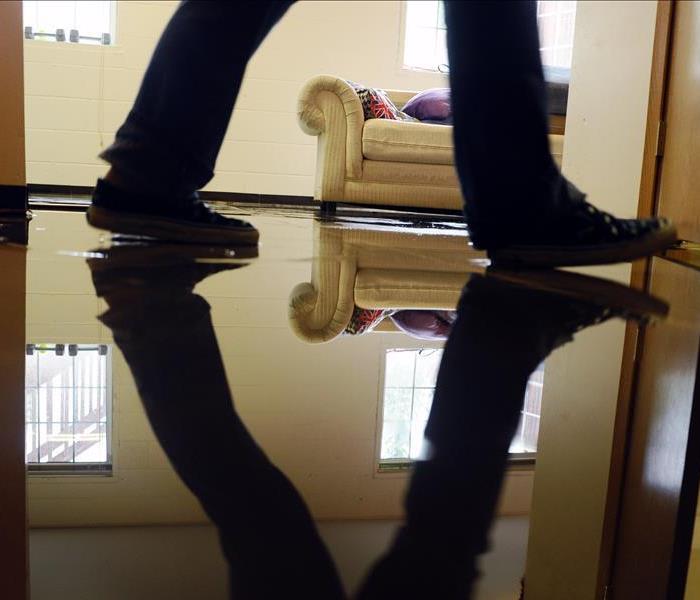 Water Damage
Water Damage
Hurricane preparations aren't just for our neighbors in the South!
We do not get very many hurricanes here in New England, but that doesn't mean that we should ignore them! We need to prepare for the season as well. We very often feel the tail ends of these storms, and with that comes wind and WATER. Often times, A LOT of rain. We may not need to batten down the hatches so to speak, But we DO need to protect our homes from potential WATER and STORM damage.
Here are some steps that you can take to prepare and protect your home.
Inspect and Repair Your Roof
A leaky roof can cause a lot more damage to your house than unsightly water stains on the ceiling. Roof leaks keep attic insulation wet, which can lead to rot and mold.
The unseen damage caused by roof leaks is often worse than what meets the eye, so it’s important to have it fixed as soon as possible. Having a reputable roofing contractor inspect your roof, check for undetected leaks, and make any needed repairs can prevent more costly damage down the road.
Document Your Possessions
Take a picture or video of your possessions. This is invaluable for Insurance claims after the storm.
Keep all important records and documents in water proof containers and if you can, maintain a digital copy of all important records and keep them in a waterproof safe or safety deposit box away from your house.
Trim Your Trees
To help prevent storm damage to your home, it’s important to trim tree branches that are growing near or hanging over your home to prevent them from breaking and crashing through the roof or damaging your siding during a storm.
Check to make sure all trees and large shrubs are alive and well, and remove any dead limbs or unhealthy plants.
Clean Your Gutters and Downspouts
It’s important to make sure to keep your gutters clean, repair any gutter leaks, and check regularly to see that they drain properly.
In addition, inspect your downspouts, remove any downspout clogs, and use splash blocks or downspout extension pipes to make sure the water is directed well away from your house foundation.
Protect Your Foundation and Basement
To help keep your basement dry and prevent flooding around your home, make sure the ground slopes away from your home’s foundation by at least 6” over the first 10’. In addition, consider having a sump pump installed in your basement to remove any ground water that may seep in.
In the case that water does find its way inside your basement, leave a 1/2″ to 1” gap between the bottom of the drywall and the basement floor to prevent moisture from creeping up the wallboard and causing mold to grow within the walls. Hide the gap with strips of wood molding or rubberized floor trim.
If you have appliances, such as a washer and dryer or a furnace in your basement, make sure that they are high enough off of the basement floor level to avoid damage.Consider putting them on cinder blocks.
Even with the best preparations in the world; Mother Nature sometimes wins! If you find your home has suffered STORM and or WATER damage contact SERVPRO of Lebanon/Hanover/Littleton. We are prepared and READY to handle your needs. To contact us Click here.
Like it never even happened.
Winter is approaching fast! Prevent Storm Damage today!
9/7/2018 (Permalink)
What You Need to Know About Preventing Winter Storm Damage
We all love a snow day!! But the reality is that major winter storms can wreak havoc in our everyday lives, causing inconvenience, discomfort and expensive damage. Keep your home protected from these disruptions by following these tips.
Keep gutters clear
- This keeps ice from building up in the gutters and contributing to the formation of ice dams, which may cause water to back up underneath shingles.
- Trim trees and shrubs back far enough so that they will not rub against or fall onto your roof or siding, even if weighed down with snow and ice. Remember, safety first. Call a professional if you need help.
Inspect the roof
- Keep an eye out for damaged shingles and roof flashing that can allow water and ice into your home.
- Ventilate the attic and insulate the attic floor to stop warm air in the house from melting snow and ice on the roof.
Check your Chimney
- Wind and heavy rains can lead to a leaky chimney and related water damage. Be sure your chimney has a chimney cap installed, and have the brick and mortar inspected periodically.
- The freeze/thaw cycle will eventually cause cracks.
- If your chimney is leaning, Get it repaired.
Invest in a roof rake
- If large amounts of snow accumulate on your roof, consider using a roof rake to remove some of the load that can cause leaks and even lead to collapse.
- Check for loose or missing shingles.
Insulate pipes
- Look for exposed water supply lines that are located in unheated areas and exterior walls. Wrap them with an insulating pipe sleeve or heat tape to stop the pipes from freezing and bursting in very cold weather.
- Let water trickle from faucets connected to exposed pipes that run through unheated spaces to prevent pipes from freezing.
- Open kitchen and bathroom cabinet doors to allow warm air circulation around the pipes.
Find the main water valve
- Know where the main water valve is located (typically in the basement or outside near the curb) so you can turn water off quickly if a pipe bursts.
Keep walkways clear
- Ensure personal safety after a storm hits by clearing snow and ice from sidewalks, steps and driveways. Treat these surfaces with rock salt or deicing products.
- For more environmentally safe products to melt ice on walkways, visit the EPA website for a complete list of recommended products. https://www.epa.gov/saferchoice/products
To learn more about storm damage cleanup and restoration, contact: SERVPRO of Lebanon/Hanover/Littleton at 603.298.6942
Storm Protection
9/7/2018 (Permalink)
Living in New Hampshire or Vermont we don't see very many tornadoes.
However, you can never be too careful, and being prepared for ANY storm disaster is always a good idea! Here in New Hampshire and Vermont, we need to be ready for windstorms, flash flooding, hurricanes and strong thunderstorms.Hurricane season usually runs from June 1 to November 30th.Here are some safety precaution tips for strong thunderstorms.
Act Now to be Prepared
- Know the county in which you live and the names of nearby cities. Severe weather warnings are issued on a county basis.
- Have disaster supplies on hand, including:
- Flashlight and extra batteries.
- Battery operated radio.
- First aid kit and manual.
- Emergency food and water.
- Non-electric can opener.
- Essential medicines.
- Checkbook, cash, credit cards, ATM cards.
Before the Storm
- Check the weather forecast before leaving for extended periods outdoors.
- If a storm is approaching, keep a NOAA Weather Radio or AM/FM radio with you.
- Postpone outdoor activities if storms are imminent.
- Check on neighbors who require special assistance: infants, the elderly, and people with disabilities.
During the Storm
- Remember: If you can hear thunder, you are close enough to the storm to be struck by lightning. Go to safe shelter immediately.
- Move to a sturdy building or car. Do Not take shelter in small sheds, under isolated trees, or in convertible automobiles.
- If lightning occurs and sturdy shelter is not available, get inside a hard top automobile and keep the windows up.
- Get out of boats and away from water.
- Telephone lines and metal pipes can conduct electricity. Unplug appliances not necessary for obtaining weather information. Avoid using the telephone or any electrical appliances. Use phones only in an emergency.
- Do not take a bath or shower.
- Turn off air conditioners. Power can overload the compressors.
- Get to higher ground if flash flooding or flooding is possible. Do Not attempt to drive to safety. Most flash flooding deaths occur in automobiles.
- If you are caught outdoors and no shelter is nearby.
- Find a low spot away from trees, fences, and poles. Make sure the place you pick is not subject to flooding.
- If you are in the woods, take shelter under the shorter trees.
- If you feel your skin tingle or your hair stand on end, squat low to the ground on the balls of your feet. Place your hands on your knees with your head between them. Make yourself the smallest target possible; minimize your contact with the ground.
After the Storm
- Check on neighbors who may require special assistance: infants, the elderly, and people with disabilities.
- Avoid all downed power lines. Assume that all have live electricity.
- Continue to monitor NOAA Weather Radio and your local media for latest weather updates.
For more information on storm damage and cleanup Click Here.
Or contact SERVPRO of Lebanon/Hanover/Littleton at 603.298.6942.
When Storms or Floods hit our Communities SERVPRO is READY!
8/25/2018 (Permalink)
 Storm truck
Storm truck
When Storms or Floods Hit
SERVPRO of Lebanon/Hanover/Littleton specializes in storm and flood damage restoration. Our crews are highly trained and we use specialized equipment to restore your property to its pre-storm condition.
Faster Response
Since we are locally owned and operated, we are able to respond quicker with the right resources, which is extremely important. A fast response lessens the damage, limits further damage, and reduces the restoration cost.
Resources to Handle Floods and Storms
When storms hit Our Communities, we can scale our resources to handle a large storm or flooding disaster. We can access equipment and personnel form a network of 1,650 Franchises across the country and elite Disaster Recovery Teams
Have Storm or Flood Damage? Call Us Today 603.298.6942
#SERVPROofLebanon/Hanover/Littleton #SERVPRO603 #HereToHelp #SERVPROCares
To learn more about storm clean up and response click here
What if the Storm Hit
7/10/2018 (Permalink)
Storm TruckWhen Storms or Floods Hit
SERVPRO of Lebanon/Hanover/Littleton specializes in storm and flood damage restoration. Our crews are highly trained and we use specialized equipment to restore your property to its pre-storm condition.
Faster Response
Since we are locally owned and operated, we are able to respond quicker with the right resources, which is extremely important. A fast response lessens the damage, limits further damage, and reduces the restoration cost.
Resources to Handle Floods and Storms
When storms hit Our Communities, we can scale our resources to handle a large storm or flooding disaster. We can access equipment and personnel form a network of 1,650 Franchises across the country and elite Disaster Recovery Teams
Have Storm or Flood Damage? Call Us Today 603.298.6942
#SERVPROofLebanon/Hanover/Littleton #SERVPRO603 #HereToHelp #SERVPROCares
To learn more about storm clean up and response Click Here!!!
Storm Safety
5/31/2018 (Permalink)
Living in New Hampshire or Vermont wedon't see many or highly destructive tornadoes. However, you can never be too careful, and being prepared for ANY storm disaster is always a good idea!The summer months Here in New Hampshire and Vermont, we need to be ready for windstorms, flash flooding, hurricanes/ tropicalstorms.Hurricane season usuallyruns from June 1 to November 30th.Here are some safety precautiontips for outdoors.
Safety precautions outdoors
- If the weather forecast calls for thunderstorms, postpone your trip or activity.
- Remember: When thunder roars, go indoors. Find a safe, enclosed shelter.
- The main lightning safety guide is the 30-30 rule. After you see lightning, start counting to 30. If you hear thunder before you reach 30, go indoors. Suspend activities for at least 30 minutes after the last clap of thunder.
- If no shelter is available, crouch low, with as little of your body touching the ground as possible. Lightning causes electric currents along the top of the ground that can be deadly over 100 feet away.
- Stay away from concrete floors or walls. Lightning can travel through any metal wires or bars in concrete walls or flooring.
Although you should move into a non-concrete structure if possible, being indoors does not automatically protect you from lightning. In fact, about one-third of lightning-strike injuries occur indoors.
Some safety precautions for indoors
Safety precautions indoors
- Avoid water during a thunderstorm. Lightning can travel through plumbing.
- Avoid electronic equipment of all types. Lightning can travel through electrical systems and radio and television reception systems.
- Avoid corded phones. However, cordless or cellular phones are safe to use during a storm.
- Avoid concrete floors and walls.
It is also a good idea to have a disaster supply kit ready as well. Things to include are:
- Water- 1 gallon, per person, per day
- Food- 3-7 days' worth of non perishable or canned food-with can manual can opener.
- Bedding- Blankets and pillows
- Clothing- Even when the weather is warm, for safety while cleaning and working, wearing long-sleeve or and pants are good to help protect your skin
- First aid kit- First aid kits are always important. In this situation bandages and sanitizer are the minimal to have at hand, however it is always better to have more!
- Cash- Always a good idea in a storm event to have some cash on hand.
Hurricanes, along with most storms, are unpredictable. Being prepared is always a good idea. You should have a an escape plan ready, somewhere to stay out of harms way. Making a list of items you own is also a good idea, along with photos of items. Keep more than one copy . Take necessary steps to protect your home or business. Having SERVPRO's Emergency Ready Plan is also a great idea!SAFFIR-SIMPSON HURRICANE SCALE
- Category 1- Winds from 74-95 mph. Minimal damage level
- Category 2- Winds from 96-110 mph. Moderate damage level
- Category 3- Winds from 111-130 mph. Extensive damage level
- Category 4- Winds from 131-155 mph. Extreme damage level
- Category 5- Winds that exceed 155 mph. Catastrophic damage level
For more information on Storm Damage and CleanupClick Here
#SERVPROofLebanon/Hanover/Littleton #SERVPRO603 #HereToHelp
ICE DAMS CAN CAUSE DAMAGE!
12/12/2017 (Permalink)
As winter approaches, we all want to be prepared. What we never seem to prepare for is ice damming. What is ice damming? An ice dam is formed when you have a lot of heat loss through your roof, causing snow to melt and run down and freeze as it gets close to the edge of the roof. This can be seen by blocks of ice on the edge of a roof, or large icicles that hang from the roof. Simple enough to explain, however they can cause big damage.
When you get an ice dam, the snow that continues to melt will get trapped by the dam and have no place to go, and can then back up under the shingles causing a leak. Many roof leaks in the late winter/early spring are from ice dams.
To prevent ice dams, and of course the latter water damage, the first step is to limit the amount of heat loss through your roof. Making sure you are insulated well enough is key. You will then also want to rid of the snow on the bottom of the roof before it turns to ice. If you already see ice dams forming, you can try and cut through the ice to make channels for water to flow off the roof, or on warmer days use warm tap water to assist in melting, however, this is a temporary fix.
If you happen to suffer a water damage caused by ice dams, call SERVPRO of Lebanon/Hanover/Littleton at 603.298.6942
#SERVPROofLebanon/Hanover/Littleton #SERVPRO603 #HereToHelp
Thunderstorms in New Hampshire
9/20/2017 (Permalink)
 Thunderstorms
Thunderstorms
Today’s Topic is Thunderstorms!
Summer in NH brings those triple H days – hazy, hot, and humid! On days like those there’s nothing more welcome than the arrival of a late-afternoon thunderstorm, leaving in its wake cool, refreshing air, scrubbed clean of haze and pollution.
Thunderstorms need three things:
- Moisture—to form clouds and rain.
- Unstable Air—relatively warm air that can rise rapidly.
- Lift—fronts, sea breezes and mountains are capable of lifting air to help form thunderstorms.
More Facts about thunderstorms:
- Thunderstorms may occur singly, in clusters, or in lines.
- Some of the most severe occur when a single thunderstorm affects one location for an extended time.
- Thunderstorms typically produce heavy rain for a brief period, anywhere from 30 minutes to an hour.
- Warm, humid conditions are highly favorable for thunderstorm development.
- About 10 percent of thunderstorms are classified as severe—one that produces hail at least three-quarters of an inch in diameter, has winds of 58 miles per hour or higher, or produces a tornado.
To learn more about how Storm Damage Cleanup and Restoration click here.
#SERVPROofLebanon/Hanover/Littleton #SERVPRO603 #HereToHelp
FLASH FLOODING!
9/6/2017 (Permalink)
What is Flash Flooding?
A flash flood is a rapid flooding of geomorphic low-lying areas: washes, rivers, dry lakes and basins. It may be caused by heavy rain associated with a severe thunderstorm, hurricane, tropical storm, or meltwater from ice or snow flowing over ice sheets or snowfield.
During A Storm or Heavy Rains:
Be aware that flash flooding can occur. If there is any possibility of a flash flood, move immediately to higher ground. Do not wait for instructions to move.
If you must prepare to evacuate, you should do the following:
Turn off utilities at the main switches or valves if instructed to do so. Disconnect electrical appliances. Do not touch electrical equipment if you are wet or standing in water.
Secure your home. If you have time, bring in outdoor furniture. Move essential items to an upper floor.
Be aware of stream, drainage channels, canyons and other areas known to flood suddenly. Flash floods can occur in these areas with or without typical warnings such as rain clouds or heavy rain.
If you have to leave your home, remember these evacuation tips:
Do not walk through moving water. Six inches of moving water can make you fall. If you have to walk in water, walk where the water is not moving. Use a stick to check the firmness of the ground in front of you.
Do not drive into flooded areas. If floodwaters rise around your car, abandon the car and move to higher ground if you can do so safely. You and the vehicle can be swept away quickly.
- Do not camp or park your vehicle along streams, rivers or creeks, particularly during threatening conditions.
Have Storm or Flood Damage? Call Us Today 603.298.6942
#SERVPROofLebanon/Hanover/Littleton #SERVPRO603 #HereToHelp #SERVPROCares
To learn more about storm clean up and response click here
MICROBURSTS!
9/6/2017 (Permalink)
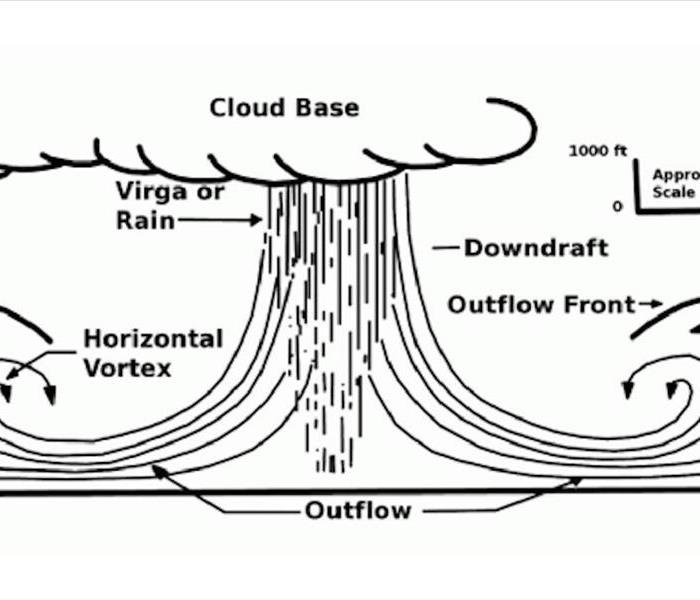 Microbursts
Microbursts
Microbursts What Are They?
Dennis Mersereau explains
Microbursts, also called "downbursts," are a sudden downward burst of wind from the base of a thunderstorm. The air can rush towards the ground at speeds of 60 MPH before impacting the surface and spreading out in all directions. Winds at the surface can exceed 100 MPH in the strongest microbursts, often causing extensive tree and building damage.
As the name suggests, microbursts tend to affect a small area, no larger than a few square miles in most cases. The intense damage these wind events leave behind can cause residents to think they had a tornado. While weak tornadoes and microbursts can produce similar amounts of damage, there is a marked swirl in tornado debris on the ground when viewed from above, while microbursts produce damage in a starburst pattern, with straight-line winds radiating away from the point of impact.
Two Types of Microbursts
There are two types of microbursts—dry microbursts and wet microbursts—each native to certain parts of the United States.
Dry Microbursts
Drier climates, such as Denver, experience dry microbursts. Dry microbursts hit the ground without any precipitation, making them virtually impossible to see unless they kick up dust and dirt at the surface. Dry air entrainment is basically the only process driving these wind events.
Wet Microbursts
East of the Rockies, especially in the southeastern United States, wet microbursts are dominant. Wet microbursts form from both dry air entrainment (causing cold air to sink towards the ground) and water loading (weight of the rain dragging the air). Seen from a distance, wet microbursts look like an upside-down mushroom cloud—a narrow rainshaft extending from the cloud to the ground, with a large burst of wind-driven water and dirt puffing away from the point of impact at the surface.
To learn more about how Storm Damage Cleanup and Restoration click here.
#SERVPROofLebanon/Hanover/Littleton #SERVPRO603 #HereToHelp
What if your home suffers storm damage?
8/28/2017 (Permalink)
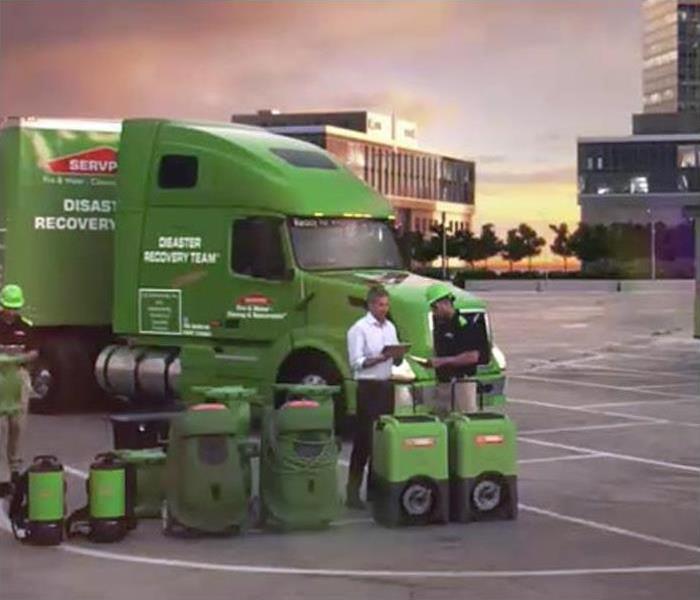 Storm
Storm
If Your Home Suffers Damage!
Weather in the Northeast can be unpredictable!
- Rain isn’t the only thing leaving its mark on our homes. Storms are still whipping through our towns and communities causing power outages and home damage. According to the National Storm Damage Center (NSDC), damage caused by trees during severe weather account for over $1 billion in property damage. Broken limbs or trees can cause mass amounts of damage to your property if they make contact. Such damage can be done to roofing, siding, windows and even structure to the home, causing lots of expensive repairs. Unfortunately there is no way to stop the unpredictable weather, but there are ways to prevent damage from happening to your home.
- Start by assessing trees close to your home. A lot of loose hanging or broken limbs should be addressed to prevent possible damage to your home or vehicles. Saving trees is important for the environment, but keeping your home and family safe is even more important. However, if a damaged tree is within reach of causing damage to you or your home, it’s better to be safe than sorry.
To find out more about SERVPRO of Lebanon/Hanover/Littleton Storm Damage Services click here.
- Have Storm or Flood Damage? Call Us Today 603.298.6942
When Storms or Floods hit our Communities SERVPRO is READY!
7/10/2017 (Permalink)
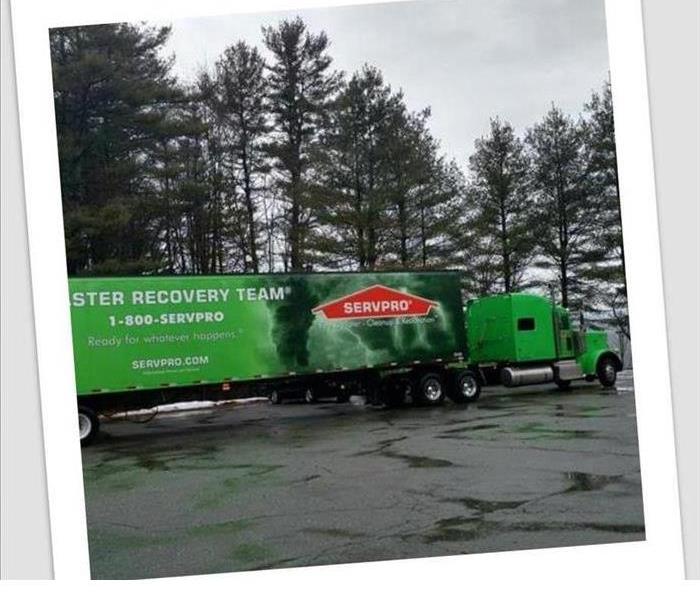 Storm Truck
Storm Truck
When Storms or Floods Hit
SERVPRO of Lebanon/Hanover/Littleton specializes in storm and flood damage restoration. Our crews are highly trained and we use specialized equipment to restore your property to its pre-storm condition.
Faster Response
Since we are locally owned and operated, we are able to respond quicker with the right resources, which is extremely important. A fast response lessens the damage, limits further damage, and reduces the restoration cost.
Resources to Handle Floods and Storms
When storms hit Our Communities, we can scale our resources to handle a large storm or flooding disaster. We can access equipment and personnel form a network of 1,650 Franchises across the country and elite Disaster Recovery Teams
Have Storm or Flood Damage? Call Us Today 603.298.6942
#SERVPROofLebanon/Hanover/Littleton #SERVPRO603 #HereToHelp #SERVPROCares
To learn more about storm clean up and response click here
Winter is approaching fast! Prevent Storm Damage today!
2/27/2017 (Permalink)
What You Need to Know About Preventing Winter Storm Damage
We all love a snow day!! But the reality is that major winter storms can wreak havoc in our everyday lives, causing inconvenience, discomfort and expensive damage. Keep your home protected from these disruptions by following these tips.
- Keep gutters clear
- This keeps ice from building up in the gutters and contributing to the formation of ice dams, which may cause water to back up underneath shingles.
- Trim trees and shrubs back far enough so that they will not rub against or fall onto your roof or siding, even if weighed down with snow and ice. Remember, safety first. Call a professional if you need help.
- Inspect the roof
- Keep an eye out for damaged shingles and roof flashing that can allow water and ice into your home.
- Ventilate the attic and insulate the attic floor to stop warm air in the house from melting snow and ice on the roof.
- Check your Chimney
- Wind and heavy rains can lead to a leaky chimney and related water damage. Be sure your chimney has a chimney cap installed, and have the brick and mortar inspected periodically.
- The freeze/thaw cycle will eventually cause cracks.
- If your chimney is leaning, Get it repaired.
- Invest in a roof rake
- If large amounts of snow accumulate on your roof, consider using a roof rake to remove some of the load that can cause leaks and even lead to collapse.
- Check for loose or missing shingles.
- Insulate pipes
- Look for exposed water supply lines that are located in unheated areas and exterior walls. Wrap them with an insulating pipe sleeve or heat tape to stop the pipes from freezing and bursting in very cold weather.
- Let water trickle from faucets connected to exposed pipes that run through unheated spaces to prevent pipes from freezing.
- Open kitchen and bathroom cabinet doors to allow warm air circulation around the pipes.
- Find the main water valve
- Know where the main water valve is located (typically in the basement or outside near the curb) so you can turn water off quickly if a pipe bursts.
- Keep walkways clear
- Ensure personal safety after a storm hits by clearing snow and ice from sidewalks, steps and driveways. Treat these surfaces with rock salt or deicing products.
To learn more about Storm Damage Cleanup and Restoration Click here!
#SERVPROofLebanon/Hanover/Littleton #SERVPRO603 #HereToHelp






 24/7 Emergency Service
24/7 Emergency Service












